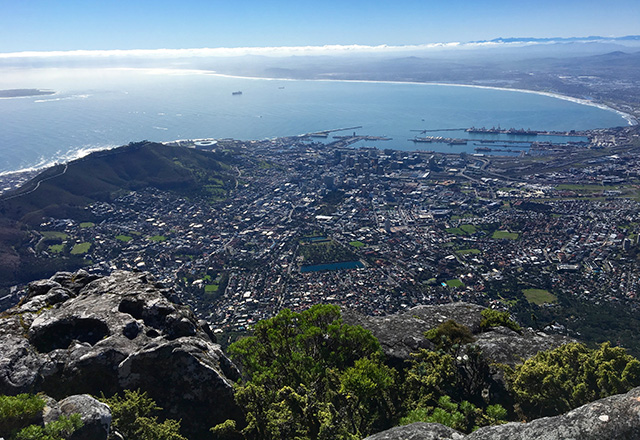I went to Cape Town, South Africa, to perform predissertation research on water management. I returned home with a transformed attitude toward personal water conservation.
Soon after I landed in Cape Town in mid-June, I heard the catchy phrase: “If it’s yellow, let it mellow. If it’s brown, flush it down.” In case you are unfamiliar with this idea, “yellow” refers to urine, and “brown” refers to stool. In an effort to conserve water, residents of Cape Town refrain from flushing the toilet unless they poop. Although Cape Town is in the middle of winter, its rainy season, city residents still abide by this saying and are still hyperaware of the water they consume. How did this all start? Why does Cape Town have such a pervasive culture of water conservation?
Cape Town has long struggled with maintaining dependable water supplies. Although Table Bay provides a good natural harbor, its geography is prone to freshwater shortages. Groundwater sources feed the springs and rivers that serve as the city’s main water supply. However, the groundwater comes from the rains, which only come in the winter, leaving the summer months prone to drought. As such, water shortages have long plagued the city. From 1827 to the mid-1840s, Superintendent of Waterworks John Chisholm tried to ration the available water by limiting the number of gallons per day that residents consumed. To those who wanted water piped directly onto their property, Chisholm limited households to 100 gallons per day and businesses to 300 gallons per day. Public fountains used by poorer residents, market stalls and even fire hydrants all had a limited daily amount of water.
The regulation of water consumption has persisted to this day. I faced an odd reality living and performing research in Cape Town. Each morning, I made myself a cup of tea, which I was careful to consume entirely. I then took a five- to 10-minute shower, just long enough to clean myself properly. Afterward, I went to the Western Cape Archives, where I read about 19th-century misuse and “wastage” of water. If I needed to use the archives’ bathroom, I could use only one of the two women’s toilets; the second was always turned off and locked. After taking the bus home, I made myself an afternoon cup of tea, which, again, I consumed whole. If I prepared dinner for my host family, I used kitchen towels to wipe my hands or dipped them in a bowl of water in the sink. When I brushed my teeth at night, I turned the tap off in between uses. I finally flushed the toilet before going to bed, typically the only time I flushed it each day.
Water shortage in Cape Town is a recognized public health hazard that the entire city, from the mayor to the smallest child, works to control. As one Cape Town resident mentioned to me, you never know how pervasive water is in your life until it’s gone. Running out of water limits your ability to keep yourself and your household clean, cook meals, grow fruits and vegetables, and maintain public spaces. At the same time, water can kill. Recent research shows that some of Cape Town’s water springs contain high levels of contaminants, including E. coli. In fact, to keep people from taking water from their private property, compounds in wealthier neighborhoods like Oranjezicht and Vredehoek have signs nailed to their gates: “Non-potable water in use,” “water taken from rain-water tanks,” “grey water in use.” These signs, meant to stop outsiders from tapping into private water supplies, are placed next to security notices, reminding passersby of Cape Town’s two most pressing problems: the city’s rating as the most dangerous in the world and its annual water shortages.
Reading the archives and experiencing the everyday conservation efforts of Cape Town residents made me consider water usage at home in the States. When I took a tour of Cape Town’s Victorian waterworks in early July, my tour guide asked me where I was from in America. “Baltimore, Maryland,” I replied. “And where do you get your water there?” he asked. I furrowed my brow in thought. “I’m not sure,” I said, “and that’s frightening, because I should know.” I later looked up the answer only to find articles like this one about Druid Lake. According to the author, the Maryland Department of the Environment recently found high levels of pollution in Druid Lake’s water, which is supposed to supply over 1 million of Baltimore’s residents. Baltimore City has shut down the lake as a result, emphasizing the fragility of our water supply. The Cape Town water crisis has exposed global fears about major cities running dry, but Baltimoreans, among thousands of other Americans, hardly realize that this problem is at their doorsteps — or more appropriately showers and sinks — too. Perhaps we can learn something from South Africa, both historically and contemporaneously:
If it’s yellow, let it mellow. If it’s brown, flush it down.
Related content
- From Baltimore to Guatemala: Experiences in Global Health
- Telemedicine and the Brazilian Health Care System
- Medical Education Around the World
Want to read more from the Johns Hopkins School of Medicine? Subscribe to the Biomedical Odyssey blog and receive new posts directly in your inbox.
